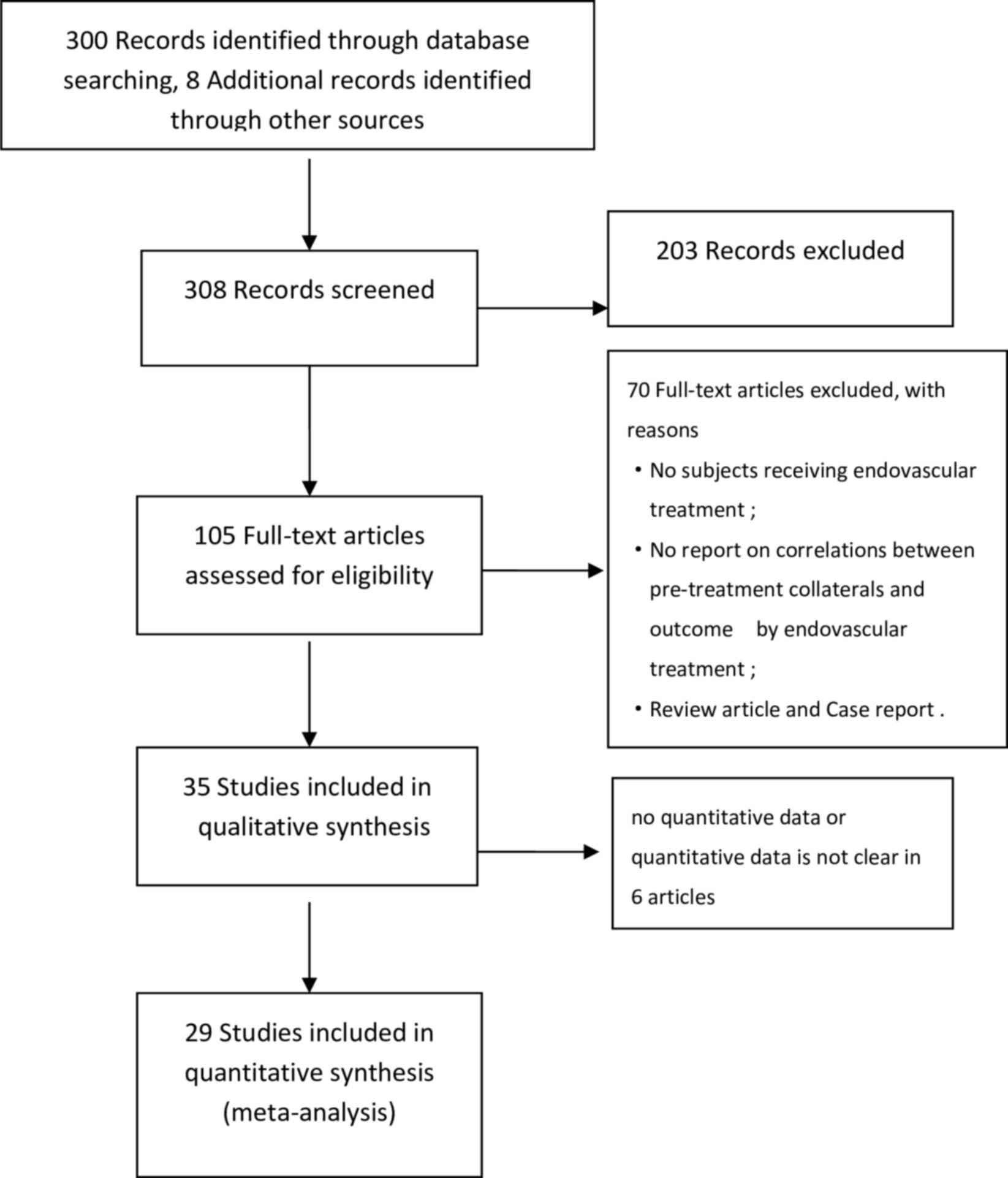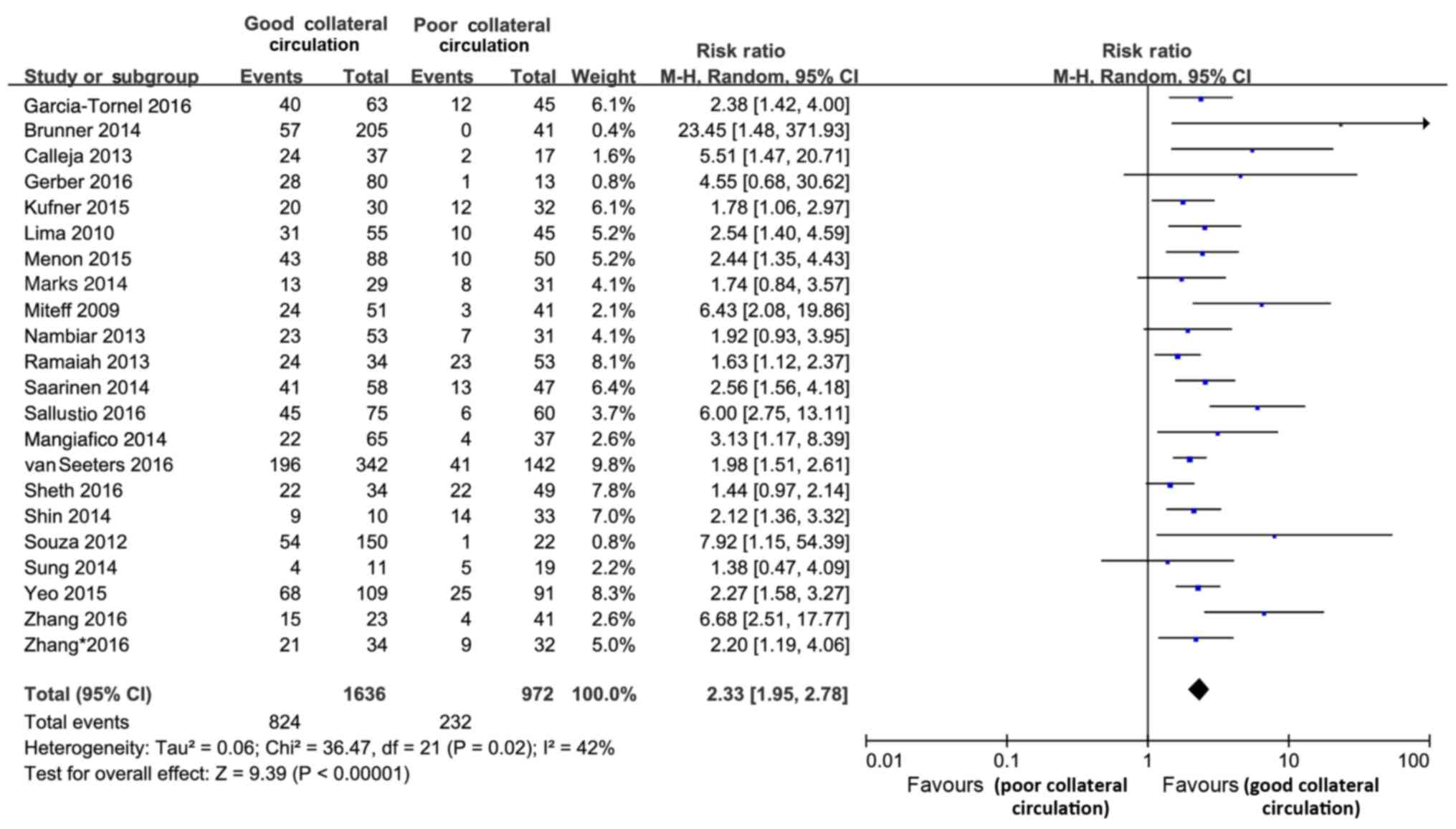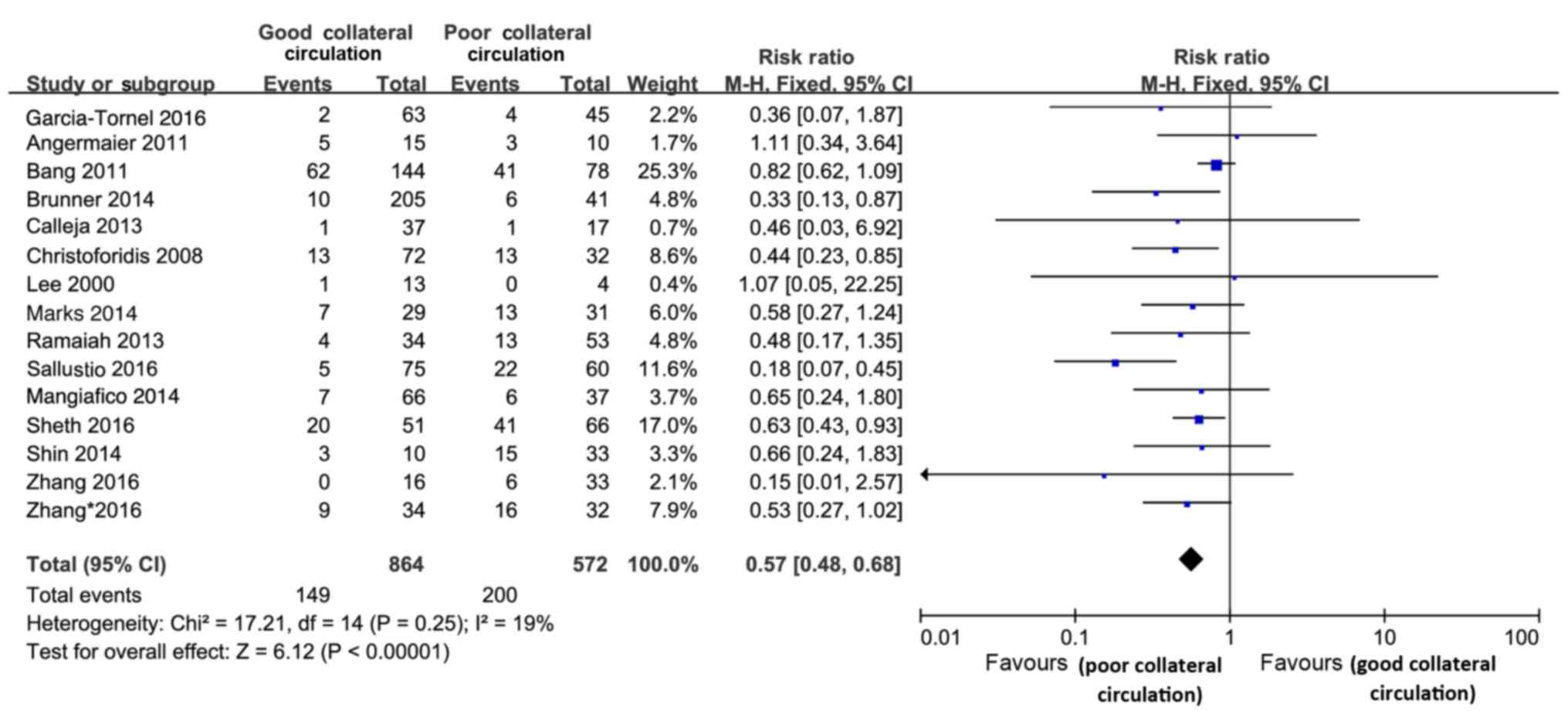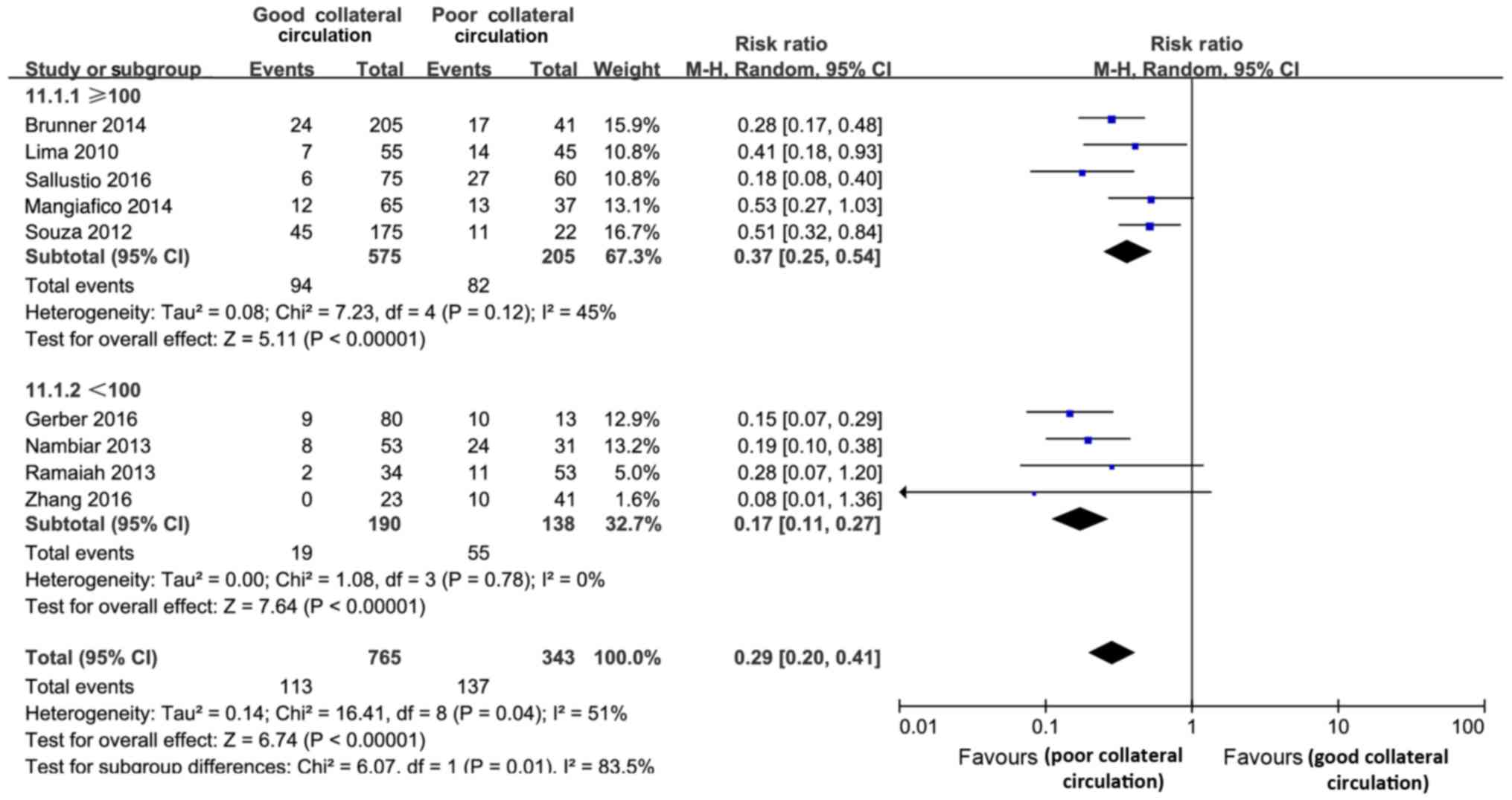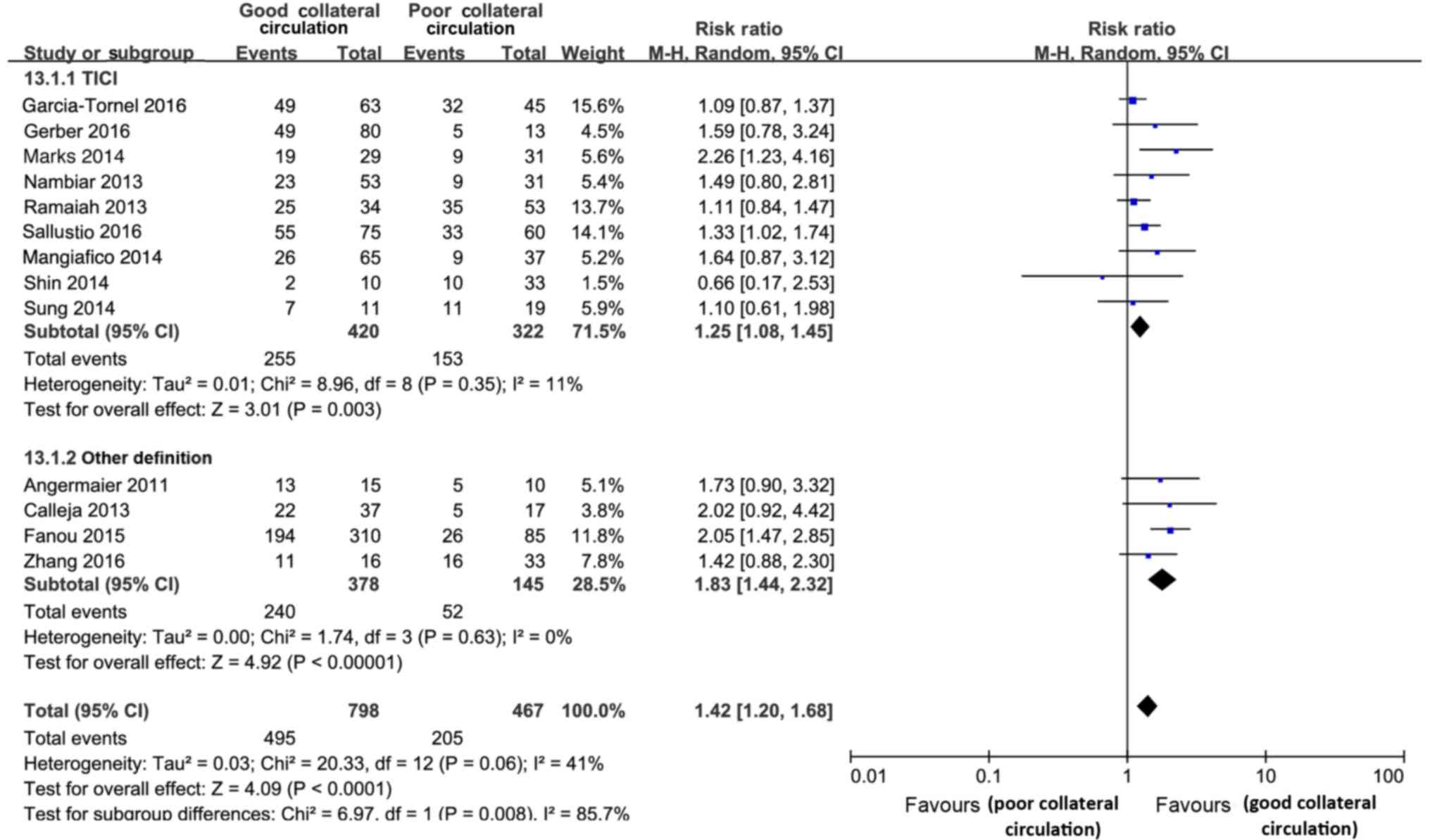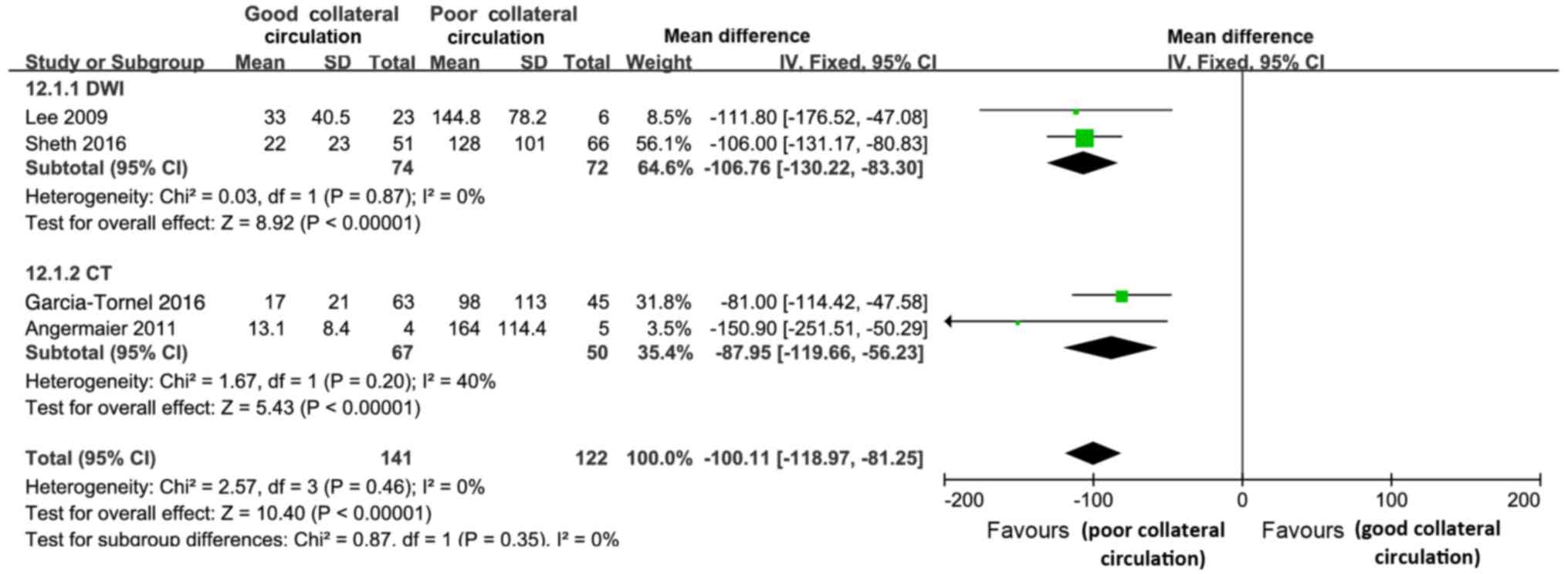|
1
|
Hankey GJ: Stroke. Lancet.
389:641–6542016.
|
|
2
|
Angermaier A, Langer S, Kirsch M, Kessler
C, Hosten N and Khaw AV: CT-angiographic collateralization predicts
final infarct volume after intra-arterial thrombolysis for acute
anterior circulation ischemic stroke. Cerebrovasc Dis. 31:177–184.
2011. View Article : Google Scholar : PubMed/NCBI
|
|
3
|
Shuaib A, Butcher K, Mohammad AA, Saqqur M
and Liebeskind DS: Collateral blood vessels in acute ischaemic
stroke: A potential therapeutic target. Lancet Neurol. 10:909–921.
2011. View Article : Google Scholar : PubMed/NCBI
|
|
4
|
Ribo M, Flores A, Rubiera M, Pagola J,
Sargento-Freitas J, Rodriguez-Luna D, Coscojuela P, Maisterra O,
Piñeiro S, Romero FJ, et al: Extending the time window for
endovascular procedures according to collateral pial circulation.
Stroke. 42:3465–3469. 2011. View Article : Google Scholar : PubMed/NCBI
|
|
5
|
Bang OY, Goyal M and Liebeskind DS:
Collateral circulation in ischemic stroke: Assessment tools and
therapeutic strategies. Stroke. 46:3302–3309. 2015. View Article : Google Scholar : PubMed/NCBI
|
|
6
|
Bang OY, Saver JL, Kim SJ, Kim GM, Chung
CS, Ovbiagele B, Lee KH and Liebeskind DS: Collateral flow predicts
response to endovascular therapy for acute ischemic stroke. Stroke.
42:693–699. 2011. View Article : Google Scholar : PubMed/NCBI
|
|
7
|
Christoforidis GA, Karakasis C, Mohammad
Y, Caragine LP, Yang M and Slivka AP: Predictors of hemorrhage
following intra-arterial thrombolysis for acute ischemic stroke:
The role of pial collateral formation. AJNR Am J Neuroradiol.
30:165–170. 2009. View Article : Google Scholar : PubMed/NCBI
|
|
8
|
Bang OY, Saver JL, Kim SJ, Kim GM, Chung
CS, Ovbiagele B, Lee KH and Liebeskind DS; UCLA-Samsung Stroke
Collaborators, : Collateral flow averts hemorrhagic transformation
after endovascular therapy for acute ischemic stroke. Stroke.
42:2235–2239. 2011. View Article : Google Scholar : PubMed/NCBI
|
|
9
|
Leng X, Lan L, Liu L, Leung TW and Wong
KS: Good collateral circulation predicts favorable outcomes in
intravenous thrombolysis: A systematic review and mate-analysis.
Eur J Neurol. 23:1738–1749. 2016. View Article : Google Scholar : PubMed/NCBI
|
|
10
|
Moher D, Liberati A, Tetzlaff J and Altman
DG; PRISMA Group, : Preferred reporting items for systematic
reviews and meta-analyses: The PRISMA statement. Ann Intern Med.
151:264–269, W64. 2009. View Article : Google Scholar : PubMed/NCBI
|
|
11
|
Stroup DF, Berlin JA, Morton SC, Olkin I,
Williamson GD, Rennie D, Moher D, Becker BJ, Sipe TA and Thacker
SB: Meta-analysis of observational studies in epidemiology: A
proposal for reporting. Meta-analysis of observational studies in
epidemiology (MOOSE) group. JAMA. 283:2008–2012. 2000. View Article : Google Scholar : PubMed/NCBI
|
|
12
|
García-Tornel A, Carvalho V, Boned S,
Flores A, Rodríguez-Luna D, Pagola J, Muchada M, Sanjuan E,
Coscojuela P, Juega J, et al: Improving the evaluation of
collateral circulation by multiphase computed tomography
angiography in acute stroke patients treated with endovascular
reperfusion therapies. Interv Neurol. 5:209–217. 2016. View Article : Google Scholar : PubMed/NCBI
|
|
13
|
Angermaier A, Langner S, Kirsch M, Kessler
C, Hosten N and Khaw AV: CT-angiographic collateralization predicts
final infarct volume after intra-arterial thrombolysis for acute
anterior circulation ischemic stroke. Cerebrovasc Dis. 31:177–184.
2011. View Article : Google Scholar : PubMed/NCBI
|
|
14
|
Berkhemer OA, Jansen IG, Beumer D, Fransen
PS, van den Berg LA, Yoo AJ, Lingsma HF, Sprengers ME, Jenniskens
SF, Lycklama À, Nijeholt GJ, et al: Collateral status on baseline
computed tomographic angiography and intra-arterial treatment
effect in patients with proximal anterior circulation stroke.
Stroke. 47:768–776. 2016.PubMed/NCBI
|
|
15
|
Brunner F, Tomandl B, Hanken K,
Hildebrandt H and Kastrup A: Impact of collateral circulation on
early outcome and risk of hemorrhagic complications after systemic
thrombolysis. Int J Stroke. 9:992–998. 2014. View Article : Google Scholar : PubMed/NCBI
|
|
16
|
Calleja AI, Cortijo E, García-Bermejo P,
Gómez RD, Pérez-Fernández S, Del Monte JM, Muñoz MF,
Fernández-Herranz R and Arenillas JF: Collateral circulation on
perfusion-computed tomography-source images predicts the response
to stroke intravenous thrombolysis. Eur J Neurol. 20:795–802. 2013.
View Article : Google Scholar : PubMed/NCBI
|
|
17
|
Fanou EM, Knight J, Aviv RI, Hojjat SP,
Symons SP, Zhang L and Wintermark M: Effect of collaterals on
clinical presentation, baseline imaging, complications, and outcome
in acute stroke. AJNR Am J Neuroradiol. 36:2285–2291. 2015.
View Article : Google Scholar : PubMed/NCBI
|
|
18
|
Gerber JC, Petrova M, Krukowski P, Kuhn M,
Abramyuk A, Bodechtel U, Dzialowski I, Engellandt K, Kitzler H,
Pallesen LP, et al: Collateral state and the effect of endovascular
reperfusion therapy on clinical outcome in ischemic stroke
patients. Brain Behav. 6:e005132016. View
Article : Google Scholar : PubMed/NCBI
|
|
19
|
Kufner A, Galinovic I, Ambrosi V, Nolte
CH, Endres M, Fiebach JB and Ebinger M: Hyperintense vessels on
FLAIR: Hemodynamic correlates and response to thrombolysis. AJNR Am
J Neuroradiol. 36:1426–1430. 2015. View Article : Google Scholar : PubMed/NCBI
|
|
20
|
Lee KH, Lee SJ, Cho SJ, Na DG, Byun HS,
Kim YB, Song HJ, Jin IS and Chung CS: Usefulness of triphasic
perfusion computed tomography for intravenous thrombolysis with
tissue-type plasminogen activator in acute ischemic stroke. Arch
Neurol. 57:1000–1008. 2000. View Article : Google Scholar : PubMed/NCBI
|
|
21
|
Lee KY, Latour LL, Luby M, Hsia AW, Merino
JG and Warach S: Distal hyperintense vessels on FLAIR: An MRI
marker for collateral circulation in acute stroke? Neurology.
72:1134–1139. 2009. View Article : Google Scholar : PubMed/NCBI
|
|
22
|
Lima FO, Furie KL, Silva GS, Lev MH,
Camargo EC, Singhal AB, Harris GJ, Halpern EF, Koroshetz WJ, Smith
WS, et al: The pattern of leptomeningeal collaterals on CT
angiography is a strong predictor of long-term functional outcome
in stroke patients with large vessel intracranial occlusion.
Stroke. 41:2316–2322. 2010. View Article : Google Scholar : PubMed/NCBI
|
|
23
|
Menon BK, Qazi E, Nambiar V, Foster LD,
Yeatts SD, Liebeskind D, Jovin TG, Goyal M, Hill MD, Tomsick TA, et
al: Differential effect of baseline computed tomographic
angiography collaterals on clinical outcome in patients enrolled in
the interventional management of stroke III trial. Stroke.
46:1239–1244. 2015. View Article : Google Scholar : PubMed/NCBI
|
|
24
|
Marks MP, Lansberg MG, Mlynash M, Olivot
JM, Straka M, Kemp S, McTaggart R, Inoue M, Zaharchuk G, Bammer R,
et al: Effect of collateral blood flow on patients undergoing
endovascular therapy for acute ischemic stroke. Stroke.
45:1035–1039. 2014. View Article : Google Scholar : PubMed/NCBI
|
|
25
|
Miteff F, Levi CR, Bateman GA, Spratt N,
McElduff P and Parsons MW: The independent predictive utility of
computed tomography angiographic collateral status in acute
ischaemic stroke. Brain. 132:2231–2238. 2009. View Article : Google Scholar : PubMed/NCBI
|
|
26
|
Nambiar V, Sohn SI, Almekhlafi MA, Chang
HW, Mishra S, Qazi E, Eesa M, Demchuk AM, Goyal M, Hill MD and
Menon BK: CTA collateral status and response to recanalization in
patients with acute ischemic stroke. AJNR Am J Neuroradiol.
35:884–890. 2014. View Article : Google Scholar : PubMed/NCBI
|
|
27
|
Ramaiah SS, Churilov L, Mitchell P,
Dowling R and Yan B: The impact of arterial collateralization on
outcome after intra-arterial therapy for acute ischemic stroke.
AJNR Am J Neuroradiol. 35:667–672. 2014. View Article : Google Scholar : PubMed/NCBI
|
|
28
|
Saarinen JT, Rusanen H and Sillanpää N:
Collateral score complements clot location in predicting the
outcome of intravenous thrombolysis. AJNR Am J Neuroradiol.
35:1892–1896. 2014. View Article : Google Scholar : PubMed/NCBI
|
|
29
|
Sallustio F, Motta C, Pizzuto S, Diomedi
M, Giordano A, D'Agostino VC, Samà D, Mangiafico S, Saia V,
Legramante JM, et al: CT angiography-based collateral flow and time
to reperfusion are strong predictors of outcome in endovascular
treatment of patients with stroke. J Neurointerv Surg. 9:940–943.
2017. View Article : Google Scholar : PubMed/NCBI
|
|
30
|
Mangiafico S, Saia V, Nencini P, Romani I,
Palumbo V, Pracucci G, Consoli A, Rosi A, Renieri L, Nappini S, et
al: Effect of the interaction between recanalization and collateral
circulation on functional outcome in acute ischaemic stroke. Interv
Neuroradiol. 20:704–714. 2014. View Article : Google Scholar : PubMed/NCBI
|
|
31
|
van Seeters T, Biessels GJ, Kappelle LJ,
van der Graaf Y and Velthuis BK; Dutch acute stroke study (DUST)
investigators, : Determinants of leptomeningeal collateral flow in
stroke patients with a middle cerebral artery occlusion.
Neuroradiology. 58:969–977. 2016. View Article : Google Scholar : PubMed/NCBI
|
|
32
|
Sheth SA, Sanossian N, Hao Q, Starkman S,
Ali LK, Kim D, Gonzalez NR, Tateshima S, Jahan R, Duckwiler GR, et
al: Collateral flow as causative of good outcomes in endovascular
stroke therapy. J Neurointerv Surg. 8:2–7. 2016. View Article : Google Scholar : PubMed/NCBI
|
|
33
|
Shin NY, Kim KE, Park M, Kim YD, Kim DJ,
Ahn SJ, Heo JH and Lee SK: Dual-phase CT collateral score: A
predictor of clinical outcome in patients with acute ischemic
stroke. PLoS One. 9:e1073792014. View Article : Google Scholar : PubMed/NCBI
|
|
34
|
Souza LC, Yoo AJ, Chaudhry ZA, Payabvash
S, Kemmling A, Schaefer PW, Hirsch JA, Furie KL, González RG,
Nogueira RG and Lev MH: Malignant CTA collateral profile is highly
specific for large admission DWI infarct core and poor outcome in
acute stroke. AJNR Am J Neuroradiol. 33:1331–1336. 2012. View Article : Google Scholar : PubMed/NCBI
|
|
35
|
Sung SM, Lee TH, Cho HJ, Kang TH, Jung DS,
Park KP, Park MK, Lee JI and Ko JK: Functional outcome after
recanalization for acute pure M1 occlusion of the middle cerebral
artery as assessed by collateral CTA flow. Clin Neurol Neurosurg.
131:72–76. 2015. View Article : Google Scholar : PubMed/NCBI
|
|
36
|
Yeo LL, Paliwal P, Teoh HL, Seet RC, Chan
BP, Ting E, Venketasubramanian N, Leow WK, Wakerley B, Kusama Y, et
al: Assessment of intracranial collaterals on CT angiography in
anterior circulation acute ischemic stroke. AJNR Am J Neuroradiol.
36:289–294. 2015. View Article : Google Scholar : PubMed/NCBI
|
|
37
|
Zhang S, Chen W, Tang H, Han Q, Yan S,
Zhang X, Chen Q, Parsons M, Wang S and Lou M: The prognostic value
of a four-dimensional CT angiography-based collateral grading scale
for reperfusion therapy in acute ischemic stroke patients. PLoS
One. 11:e01605022016. View Article : Google Scholar : PubMed/NCBI
|
|
38
|
Zhang S, Zhang X, Yan S, Lai Y, Han Q, Sun
J, Zhang M, Parsons MW, Wang S and Lou M: The velocity of
collateral filling predicts recanalization in acute ischemic stroke
after intravenous thrombolysis. Sci Rep. 6:278802016. View Article : Google Scholar : PubMed/NCBI
|
|
39
|
Hacke W, Kaste M, Fieschi C, von Kummer R,
Davalos A, Meier D, Larrue V, Bluhmki E, Davis S, Donnan G, et al:
Randomised double-blind placebo-controlled trial of thrombolytic
therapy with intravenous alteplase in acute ischaemic stroke (ECASS
II). Second European-Australasian acute stroke study investigators.
Lancet. 352:1245–1251. 1998. View Article : Google Scholar : PubMed/NCBI
|
|
40
|
Ito M, Yoshimoto T, Kawabori M, Fujimoto
S, Yamauchi T, Yamaguchi H, Tokuda K and Kaneko S: Diagnostic
impact of baseline cerebral blood flow in patients with acute
ischemic stroke prior to intravenous recombinant tissue plasminogen
activator therapy. Clin Neurol Neurosurg. 115:1464–1469. 2013.
View Article : Google Scholar : PubMed/NCBI
|
|
41
|
Liebeskind DS: Imaging the future of
stroke: I. Ischemia. Ann Neurol. 66:574–590. 2009. View Article : Google Scholar : PubMed/NCBI
|
|
42
|
Liebeskind DS and Alexandrov AV: Advanced
multimodal CT/MRI approaches to hyperacute stroke diagnosis,
treatment, and monitoring. Ann N Y Acad Sci. 1268:1–7. 2012.
View Article : Google Scholar : PubMed/NCBI
|
|
43
|
Mangiafico S, Saia V, Nencini P, Romani I,
Palumbo V, Pracucci G, Consoli A, Rosi A, Renieri L, Nappini S, et
al: Effect of the interaction between recanalization and collateral
circulation on functional outcome in acute ischaemic stroke. Interv
Neuroradiol. 20:704–714. 2014. View Article : Google Scholar : PubMed/NCBI
|
|
44
|
Beyer SE, Thierfelder KM, von Baumgarten
L, Rottenkolber M, Meinel FG, Janssen H, Ertl-Wagner B, Reiser MF
and Sommer WH: Strategies of collateral blood flow assessment in
ischemic stroke: Prediction of the follow-up infarct volume in
conventional and dynamic CTA. AJNR Am J Neuroradiol. 36:488–494.
2015. View Article : Google Scholar : PubMed/NCBI
|
|
45
|
Ernst M, Forkert ND, Brehmer L, Thomalla
G, Siemonsen S, Fiehler J and Kemmling A: Prediction of infarction
and reperfusion in stroke by flow- and volume-weighted collateral
signal in MR angiography. AJNR Am J Neuroradiol. 36:275–282. 2015.
View Article : Google Scholar : PubMed/NCBI
|
|
46
|
Jickling GC, Liu D, Stamova B, Ander BP,
Zhan X, Lu A and Sharp FR: Hemorrhagic transformation after
ischemic stroke in animals and humans. J Cereb Blood Flow Metab.
34:185–199. 2014. View Article : Google Scholar : PubMed/NCBI
|
|
47
|
Arnold M, Schroth G, Nedeltchev K, Loher
T, Remonda L, Stepper F, Sturzenegger M and Mattle HP:
Intra-arterial thrombolysis in 100 patients with acute stroke due
to middle cerebral artery occlusion. Stroke. 33:1828–1833. 2002.
View Article : Google Scholar : PubMed/NCBI
|
|
48
|
McVerry F, Liebeskind DS and Muir KW:
Systematic review of methods for assessing leptomeningeal
collateral flow. AJNR Am J Neuroradiol. 33:576–582. 2012.
View Article : Google Scholar : PubMed/NCBI
|
|
49
|
Goyal M, Demchuk AM, Menon BK, Eesa M,
Rempel JL, Thornton J, Roy D, Jovin TG, Willinsky RA, Sapkota BL,
et al: Randomized assessment of rapid endovascular treatment of
ischemic stroke. N Engl J Med. 372:1019–1030. 2015. View Article : Google Scholar : PubMed/NCBI
|
|
50
|
Campbell BC, Mitchell PJ, Kleinig TJ,
Dewey HM, Churilov L, Yassi N, Yan B, Dowling RJ, Parsons MW, Oxley
TJ, et al: Endovascular therapy for ischemic stroke with
perfusion-imaging selection. N Engl J Med. 372:1009–1018. 2015.
View Article : Google Scholar : PubMed/NCBI
|
|
51
|
Berkhemer OA, Fransen PS, Beumer D, van
den Berg LA, Lingsma HF, Yoo AJ, Schonewille WJ, Vos JA, Nederkoorn
PJ, Wermer MJ, et al: A randomized trial of intraarterial treatment
for acute ischemic stroke. N Engl J Med. 372:11–20. 2015.
View Article : Google Scholar : PubMed/NCBI
|
|
52
|
Saver JL, Goyal M, Bonafe A, Diener HC,
Levy EI, Pereira VM, Albers GW, Cognard C, Cohen DJ, Hacke W, et
al: Stent-retriever thrombectomy after intravenous t-PA vs. t-PA
alone in stroke. N Engl J Med. 372:2285–2295. 2015. View Article : Google Scholar : PubMed/NCBI
|
|
53
|
Jovin TG, Chamorro A, Cobo E, de Miquel
MA, Molina CA, Rovira A, Román LS, Serena J, Abilleira S, Ribó M,
et al: Thrombectomy within 8 h after symptom onset in ischemic
stroke. N Engl J Med. 372:2296–2306. 2015. View Article : Google Scholar : PubMed/NCBI
|
|
54
|
Hallevi H, Barreto AD, Liebeskind DS,
Morales MM, Martin-Schild SB, Abraham AT, Gadia J, Saver JL; UCLA
Intra-Arterial Therapy Investigators, ; Grotta JC and Savitz SI:
Identifying patients at high risk for poor outcome after
intra-arterial therapy for acute ischemic stroke. Stroke.
40:1780–1785. 2009. View Article : Google Scholar : PubMed/NCBI
|
|
55
|
Flint AC, Kamel H, Rao VA, Cullen SP,
Faigeles BS and Smith WS: Validation of the totaled health risks in
vascular events (THRIVE) score for outcome prediction in
endovascular stroke treatment. Int J Stroke. 9:32–39. 2014.
View Article : Google Scholar : PubMed/NCBI
|















